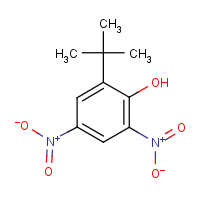Dinoterb
Agent Name
Dinoterb
CAS Number
1420-07-1
Formula
C10-H12-N2-O5
Major Category
Pesticides

Synonyms
2,4-Dinitro-6-tert-butylphenol; 2-(1,1-Dimethylethyl)-4,6-dinitrophenol; 2-tert-Butyl-4,6-dinitrophenol; 2-tert-Butyl-4,6-dinitrophenol [ISO]; Dinoterbe [ISO-French]; DNTBP; Herbogil; Phenol, 2-(1,1-dimethylethyl)-4,6-dinitro-; Phenol, 2-tert-butyl-4,6-dinitro-; Phenol, o-t-butyl-4,6-dinitro-; Phenol, o-tert-butyl-4,6-dinitro-; Stirpan forte; [ChemIDplus] UN2779
Category
Herbicides, Nitroaromatic
Description
Yellow solid with an odor of phenol; [HSDB]
Sources/Uses
Used as contact herbicide for post-emergence control of annual weeds in cereals, lucerne, and maize, and pre-emergence weed control in beans and peas; Also used as rodenticide; [HSDB]
Comments
Toxicology similar to that of Dinoseb and Dinitro-o-cresol; [HSDB] An eye irritant; Can be absorbed through skin; [MSDSonline] See "Dinitro-o-cresol "
Restricted
Banned in the EU for use as pesticide for plant protection and other pesticides including biocides; [eChemPortal: ESIS] All registrations suspended by EPA in 1986; [HSDB]
Biomedical References
Exposure Assessment
Vapor Pressure
1.1E-06 mm Hg
Explanatory Notes
The Guide in the Emergency Response Guidebook is for "Substituted nitrophenol pesticide, solid, toxic."
Adverse Effects
Methemoglobinemia
MetHgb is secondary toxic effect
Hepatotoxin
Hepatoxic (a) from occupational exposure (secondary effect) or (b) in animal studies or in humans after ingestion
Nephrotoxin
Yes
Reproductive Toxin
Yes
Other Poison
Uncoupler
Diseases, Processes, and Activities Linked to This Agent
Diseases
Occupational diseases associated with exposure to this agent:
Processes
Industrial Processes with risk of exposure: